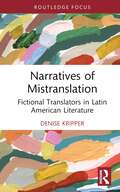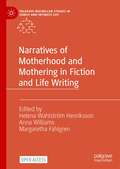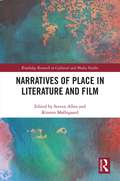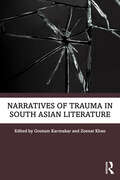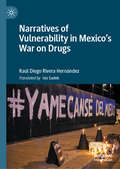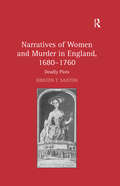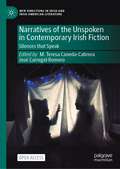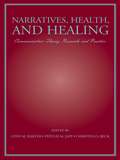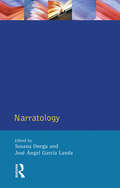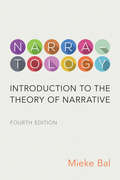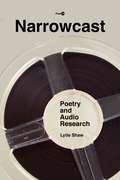- Table View
- List View
Narratives of Mistranslation: Fictional Translators in Latin American Literature (Routledge Studies in Literary Translation)
by Denise KripperThis book offers unique insights into the role of the translator in today’s globalized world, exploring Latin American literature featuring translators and interpreters as protagonists in which prevailing understandings of the act of translation are challenged and upended. The volume looks to the fictional turn as a fruitful source of critical inquiry in translation studies, showcasing the potential for recent Latin American novels and short stories in Spanish to shed light on the complex dynamics and conditions under which translators perform their task. Kripper unpacks how the study of these works reveals translation not as an activity with communication as its end goal but rather as a mediating and mediated process shaped by the unique manipulations and motivations of translators and the historical and cultural contexts in which they work. In exploring the fictional representations of translators, the book also outlines pedagogical approaches and offers discussion questions for the implementation of translators’ narratives in translation, language, and literature courses. Narratives of Mistranslation will be of interest to scholars and educators in translation studies, especially those working in literary translation and translation pedagogy, Latin American literature, world literature, and Latin American studies.
Narratives of Motherhood and Mothering in Fiction and Life Writing (Palgrave Macmillan Studies in Family and Intimate Life)
by Anna Williams Helena Wahlström Henriksson Margaretha FahlgrenThis open access volume offers original essays on how motherhood and mothering are represented in contemporary fiction and life writing across several national contexts. Providing a broad range of perspectives in terms of geopolitical places, thematic concerns, and theoretical and interdisciplinary approaches, it demonstrates the significance of literary narratives for understanding and critiquing motherhood and mothering as social phenomena and subjective experiences. The chapters contextualize motherhood and mothering in terms of their particular national and cultural location and analyze narratives about mothers who are firmly placed in one national context, as well as those who are in “in-between” positions due to migrant experiences. The contributions foreground and link together the themes central to the volume: embodied experience and maternal embodiment; notions of what is “normal” or natural (or not) about motherhood; maternal health and illness; mother-daughter relations; maternality and memory; and the (im)possibilities of giving voice to the mother. They raise questions about how motherhood and mothering are marked by absence and/or presence, as well as by profound ambivalences.
Narratives of Non-English L2 Language Teachers
by Nur Yiğitoğlu Aptoula Melinda ReicheltThis book highlights the narratives of teachers of non-English languages. Much of what we know about L2 teaching is based on conclusions drawn from research on teaching in English as an L2, with languages besides English being given short shrift or ignored entirely. Examining L2 teaching practices related to non-English languages can help us gain a more comprehensive understanding of language pedagogy. This is because different target languages play different roles in the contexts in which they are taught, which influences teaching and learning in significant ways.The contributions in this book include chapters from L2 instructors who teach a wide range of languages in different settings, including different geographical, sociolinguistic, and institutional contexts. With narratives focused on pedagogical practices and practical materials, this resource will be beneficial to pre-service teachers, teacher educators, and researchers in language education, as well as in-service teacher training programs.
Narratives of Nostalgia and Repair in American Comics and Literature: (Dis)abling Exceptionalism
by Aanchal VijThrough a study of both novels and comic books of 20th and 21st century, this book claims that it is not possible to create any narrative of exceptionalism without also manufacturing a sense of nostalgia for a past that may or may not have existed. Acts of personal or historical repair are central to such nostalgia and symptomatic of a desire to both escape and confront difficult pasts. The myth of American exceptionalism is one such narrative of nostalgia that, in its conception of damage and acts of &‘repair,&’ disables histories. Through works by Michael Chabon, Art Spiegelman, Philip Roth, Alan Moore, and Ta-Nehisi Coates, this book reframes the idea of heroism and locates it outside of the hegemonic narrative of American exceptionalism. This book puts comics studies and literature in dialogue with disability studies to argue that an &‘able&’ history, just like an &‘able body,&’ is a myth. The figure of the superhero, or the trope of heroism, is central to the moments of historical repair as well as the identity politics of who repairs the damage. The corpus illustrates how American escapism and counterfactual conception of a nation&’s past can prolong the trauma of beleaguered communities, cultures, bodies, and histories. This book reveals how prostheticising one version of history can amputate another; there is no narrative of exceptionalism that is also not simultaneously a narrative of disability.
Narratives of Obeah in West Indian Literature: Moving through the Margins
by Janelle RodriquesThis book explores representations of Obeah – a name used in the English/Creole-speaking Caribbean to describe various African-derived, syncretic Caribbean religious practices – across a range of prose fictions published in the twentieth century by West Indian authors. In the Caribbean and its diasporas, Obeah often manifests in the casting of spells, the administration of baths and potions of various oils, herbs, roots and powders, and sometimes spirit possession, for the purposes of protection, revenge, health and well-being. In most Caribbean territories, the practice – and practices that may resemble it – remains illegal. Narratives of Obeah in West Indian Literature analyses fiction that employs Obeah as a marker of the Black ‘folk’ aesthetics that are now constitutive of West Indian literary and cultural production, either in resistance to colonial ideology or in service of the same. These texts foreground Obeah as a social and cultural logic both integral to and troublesome within the creation of such a thing as ‘West Indian’ literature and culture, at once a product of and a foil to Caribbean plantation societies. This book explores the presentation of Obeah as an ‘unruly’ narrative subject, one that not only subverts but signifies a lasting ‘Afro-folk’ sensibility within colonial and ‘postcolonial’ writing of the West Indies. Narratives of Obeah in West Indian Literature will be of interest to scholars and students of Caribbean Literature, Diaspora Studies, and African and Caribbean religious studies; it will also contribute to dialogues of spirituality in the wider Black Atlantic.
Narratives of Place in Literature and Film (Routledge Research in Cultural and Media Studies)
by Steven Allen Kirsten MøllegaardNarratives of place link people and geographic location with a cultural imaginary through literature and visual narration. Contemporary literature and film often frame narratives with specific geographic locations, which saturate the narrative with cultural meanings in relation to natural and man-made landscapes. This interdisciplinary collection seeks to interrogate such connections to probe how place is narrativized in literature and film. Utilizing close readings of specific filmic and literary texts, all chapters serve to tease out cultural and historical meanings in respect of human engagement with landscapes. Always mindful of national, cultural and topographical specificity, the book is structured around five core themes: Contested Histories of Place; Environmental Landscapes; Cityscapes; The Social Construction of Place; and Landscapes of Belonging.
Narratives of Precarious Migrancy in the Global South (Routledge Research in Postcolonial Literatures)
by Gigi Adair Carly McLaughlinThis volume sets out to challenge and expand Anglophone literary migration studies in the global North with a two-fold approach. It proposes precarious migrancy as a conceptual framework to capture hitherto neglected aspects of subaltern displacement, and it turns to the global South as a site of knowledge production about migration. The chapters discuss literary narratives originally written in Chinese, Kurdish and Italian as well as English, and covering a wide geographical range, to ask what experiences and understandings of migration emerge from Southern perspectives. Across the volume, precarious migrancy emerges as a key concept for understanding contemporary globalization in general and migration in the global South in particular. The chapters offer significant reconceptualizations of precarity and migrancy by reading Southern literatures of migration as a mode of theorization of the contemporary world, contributing to the ongoing shift in framings of migration in Anglophone and postcolonial literary studies.This volume will be of significant interest to scholars in literary migration studies, global South studies, and postcolonial studies. It offers readings of rarely studied literary texts, as well as new concepts for scholars interested in understanding the nexus of literature and migration today.
Narratives of Resilience / Narrative der Resilienz (Environmental Humanities #5)
by Kate Rigby Evi ZemanekResilienz hat sich in den Environmental Humanities und darüber hinaus als Schlüsselbegriff etabliert. Dieser Open Access-Band lotet aus, wie die Literatur- und Kulturwissenschaften die Resilienzforschung erweitern können und entwickelt Konzepte kultureller und literarischer Resilienz im Angesicht der planetaren Krisen. Die Beiträge untersuchen unterschiedliche „Narrative der Resilienz&“, die das individuelle und kollektive Ringen um Widerstandskraft, Regeneration, Anpassung und Transformation schildern. Der Fokus auf narrative Praktiken gründet in der Annahme, dass insbesondere im Akt des Erzählens von überwundenen Erschütterungen und überlebten Katastrophen Resilienz entwickelt wird.
Narratives of Scale in the Anthropocene: Imagining Human Responsibility in an Age of Scalar Complexity (Routledge Interdisciplinary Perspectives on Literature)
by Gabriele Dürbeck and Philip HüpkesThe Anthropocene concept draws attention to the various forms of entanglement of social, political, ecological, biological and geological processes at multiple spatial and temporal scales. The ensuing complexity and ambiguity create manifold challenges to widely established theories, methodologies, epistemologies and ontologies. The contributions to this volume engage with conceptual issues of scale in the Anthropocene with a focus on mediated representation and narrative. They are centered around the themes of scale and time, scale and the nonhuman and scale and space. The volume presents an interdisciplinary dialogue between sociology, geography, political sciences, history and literary, cultural and media studies. Together, they contribute to current debates on the (re-)imagining of forms of human responsibility that meet the challenges created by humanity entering an age of scalar complexity.
Narratives of Scale in the Anthropocene: Imagining Human Responsibility in an Age of Scalar Complexity (Routledge Interdisciplinary Perspectives on Literature)
by Gabriele Dürbeck and Philip HüpkesThe Anthropocene concept draws attention to the various forms of entanglement of social, political, ecological, biological and geological processes at multiple spatial and temporal scales. The ensuing complexity and ambiguity create manifold challenges to widely established theories, methodologies, epistemologies and ontologies. The contributions to this volume engage with conceptual issues of scale in the Anthropocene with a focus on mediated representation and narrative. They are centered around the themes of scale and time, scale and the nonhuman and scale and space. The volume presents an interdisciplinary dialogue between sociology, geography, political sciences, history and literary, cultural and media studies. Together, they contribute to current debates on the (re-)imagining of forms of human responsibility that meet the challenges created by humanity entering an age of scalar complexity.Chapter 3 of this book is freely available as a downloadable Open Access PDF under a Creative Commons Attribution-Non Commercial-No Derivatives 4.0 license available at http://www.taylorfrancis.com/books/e/9781003136989
Narratives of Trauma in South Asian Literature
by Goutam Karmakar Zeenat KhanThis volume addresses cultural and literary narratives of trauma in South Asian literature. Presenting a novel cross-cultural perspective on trauma theory, the essays within this volume study the divergent cultural responses to trauma and violence in various parts of South Asia, including Sri Lanka, Bangladesh, Nepal, and Afghanistan, which have received little attention in literary writings on trauma in their specific circumstances. Through comprehensive sociocultural understanding of the region, this book creates an approachable space where trauma engages with themes like racial identity, ethnicity, nationality, religious dogma, and cultural environment. With case studies from Kashmir, the 1971 liberation war of Bangladesh, and armed conflict in Nepal and Afghanistan, the volume will be of interest to scholars, students and researchers of literature, history, politics, conflict studies, and South Asian studies.
Narratives of Vulnerability in Mexico's War on Drugs
by Raúl Diego Rivera HernándezThis book explores the current human rights crisis created by the War on Drugs in Mexico. It focuses on three vulnerable communities that have felt the impacts of this war firsthand: undocumented Central American migrants in transit to the United States, journalists who report on violence in highly dangerous regions, and the mourning relatives of victims of severe crimes, who take collective action by participating in human rights investigations and searching for their missing loved ones. Analyzing contemporary novels, journalistic chronicles, testimonial works, and documentaries, the book reveals the political potential of these communities’ vulnerability and victimization portrayed in these fictional and non-fictional representations. Violence against migrants, journalists, and activists reveals an array of human rights violations affecting the right to safe transit across borders, freedom of expression, the right to information, and the right to truth and justice.
Narratives of Women and Murder in England, 1680–1760: Deadly Plots
by Kirsten T. SaxtonArguing that the female criminal subject was central to the rise of the British novel, Kirsten T. Saxton provides fresh and convincing insights into the deeply complex ways in which categories of criminality, gender, and fiction intersected in the long eighteenth century. She offers the figure of the murderess as evidence of the constitutive relationship between eighteenth-century legal and fictional texts, comparing non-fiction representations of homicidal women in biographies of Newgate Ordinaries and in trial reports with those in the early novels of Aphra Behn, Delariviere Manley, Daniel Defoe, and Henry Fielding. As Saxton demonstrates that legal narratives informed the budding genre of the novel and fictional texts shaped the development of legal narratives, her study of deadly plots becomes a feminist intervention in scholarship on the literature of crime that simultaneously insists on the centrality of crime literature in feminist histories of the novel. Her epilogue shows that more than two centuries later, we still contend with displays of female violence that defy and define our notions of textual and sexual license and continue to shape legal and literary mandates, even as the lines between the real and the fictive remain blurred.
Narratives of Women’s Health and Hysteria in the Nineteenth-Century Novel (Palgrave Studies in Literature, Science and Medicine)
by Melissa RampelliNarratives of Women’s Health and Hysteria in the Nineteenth-Century Novel looks extensively at hysteria discourse through medical and sociological texts and examines how this body of work intersects with important cultural debates to define women’s social, physical, and mental health. The book sketches out prominent shifts in cultural reactions to the idea of diffused agency and the prized model of the interiorized, individual person capable of self will and governance. Melissa Rampelli takes up the work of Jane Austen, Charles Dickens, George Eliot, and Thomas Hardy, showing how the authors play with and manipulate stock literary figures to contribute to this dialogue about the causes and cures of women’s hysterical distress.
Narratives of the Unspoken in Contemporary Irish Fiction: Silences that Speak (New Directions in Irish and Irish American Literature)
by M. Teresa Caneda-Cabrera José Carregal-RomeroThis Open access book is a collection of essays and offers an in-depth analysis of silence as an aesthetic practice and a textual strategy which paradoxically speaks of the unspoken nature of many inconvenient hidden truths of Irish society in the work of contemporary fiction writers. The study acknowledges Ireland’s history of damaging silences and considers its legacies, but it also underscores how silence can serve as a valuable, even productive, means of expression. From a wide range of critical perspectives, the individual essays address, among other issues, the conspiracies of silence in Catholic Ireland, the silenced structural oppression of Celtic Tiger Ireland, the recovery of silenced stories/voices of the past and their examination in the present, as well as millennial disaffection and the silencing of vulnerability in today’s neoliberal Ireland. The book ’s attention to silence provides a rich vocabulary for understanding what unfolds in the quiet interstices of Irish writing from recent decades. This study also invokes the past to understand the present and, thus, demonstrates the continuities and discontinuities that define how silence operates in Irish culture.Grant FFI2017-84619-P AEI, ERDF, EU (INTRUTHS “Inconvenient Truths: Cultural Practices of Silence in Contemporary Irish Fiction”) Funded by the Spanish Research Agency AEI http://dx.doi.org/10.13039/501100011033 and by the European Regional Development Fund ERDF "A Way of Making Europe"
Narratives, Health, and Healing: Communication Theory, Research, and Practice (Routledge Communication Series)
by Christina S. Beck Lynn M. Harter Phyllis M. JappThis distinctive collection explores the use of narratives in the social construction of wellness and illness. Narratives, Health, and Healing emphasizes what the process of narrating accomplishes--how it serves in the health communication process where people define themselves and present their social and relational identities. Organized into four parts, the chapters included here examine health narratives in interpersonal relationships, organizations, and public fora. The editors provide an extensive introduction to weave together the various threads in the volume, highlight the approach and contribution of each chapter, and bring to the forefront the increasingly important role of narrative in health communication.This volume offers important insights on the role of narrative in communicating about health, and it will be of great interest to scholars and graduate students in health communication, health psychology, and public health. It is also relevant to medical, nursing, and allied health readers.
Narratology
by Mieke BalSince its first publication in English in 1985, Mieke Bal's Narratology has become the international classic and comprehensive introduction to the theory of narrative texts. Narratology is a systematic account of narrative techniques, methods, their transmission, and reception, in which Bal distills years of study of the ways in which we understand both literary and non-literary works. In this third edition, Bal updates the book to include more analysis of film narratives while also sharpening and tightening her language to make it the most readable and student-friendly edition to date. Bal also introduces new sections that treat and clarify several modernist texts that pose narratological challenges. With changes prompted by ten years of feedback from scholars and teachers, Narratology remains the most important contribution to the study of the way narratives work, are formed, and are received.
Narratology in Practice
by Mieke BalNarratology in Practice opens up the well-known theory of narrative to various disciplines in the humanities and social sciences. Written as a companion to Mieke Bal’s international classic Narratology: Introduction to the Theory of Narrative, in which the examples focus almost exclusively on literary studies, this new book offers more elaborate analyses of visual media, especially visual art and film. Read independently or in parallel with its companion, Narratology in Practice enables readers to use the suggested concepts as tools to assist them in practising narrative analysis.
Narratology: An Introduction (Longman Critical Readers)
by Susana Onega JoséThis text provides an excellent introduction and overview of Narratology, a rapidly growing field in the humanities. Literary narratologists have provided many key concepts and analytical tools which are widely used in the interdisciplinary analysis of such narrative features as plot, point of view, speech presentation, ideological perspective and interpretation.The introduction explains the central concepts of narratology, their historical development, and draws together contemporary trends from many different disciplines into common focus. It offers a compendium of the development of narratology from classical poetics to the present.The essays are all prefaced by individual forewords helping the reader to place each individual selection in context. Recent developments are assessed across disciplines, highlighting the mutual influences of narratology and deconstruction, psychoanalysis, feminism, film and media studies.
Narratology: Introduction to the Theory of Narrative, Fourth Edition
by Mieke BalSince its first publication in English in 1985, Mieke Bal's Narratology has become an international classic and the comprehensive introduction to the theory of narrative texts, both literary and non-literary. Providing insights into how readers interpret narrative text, the fourth edition of Narratology is a guide for students and scholars seeking to analyze narratives of any language, period, and region with clear, systematic and reliable concepts. With the addition of in-depth analysis of literary nuances and methods, award-wining cultural theorist Mieke Bal continues to present narrative concepts with clarity. Bal uses a systematic framework to better explain how narratives function, are formed, and eventually interpreted by the reader, while presenting a comprehensive study of the surface perception of language, the perceived narrative world, point of view, and characterization.
Narrowcast: Poetry and Audio Research (Post*45)
by Lytle ShawNarrowcast explores how mid-century American poets associated with the New Left mobilized tape recording as a new form of sonic field research even as they themselves were being subjected to tape-based surveillance. Media theorists tend to understand audio recording as a technique for separating bodies from sounds, but this book listens closely to tape's embedded information, offering a counterintuitive site-specific account of 1960s poetic recordings. Allen Ginsberg, Charles Olson, Larry Eigner, and Amiri Baraka all used recording to contest models of time being put forward by dominant media and the state, exploring non-monumental time and subverting media schedules of work, consumption, leisure, and national crises. Surprisingly, their methods at once dovetailed with those of the state collecting evidence against them and ran up against the same technological limits. Arguing that CIA and FBI "researchers" shared unexpected terrain not only with poets but with famous theorists such as Fredric Jameson and Hayden White, Lytle Shaw reframes the status of tape recordings in postwar poetics and challenges notions of how tape might be understood as a mode of evidence.
Nart Sagas: Ancient Myths and Legends of the Circassians and Abkhazians
by John ColarussoThe sagas of the ancient Narts are to the Caucasus what Greek mythology is to Western civilization. This book presents, for the first time in the West, a wide selection of these fascinating myths preserved among four related peoples whose ancient cultures today survive by a thread. In ninety-two straightforward tales populated by extraordinary characters and exploits, by giants who humble haughty Narts, by horses and sorceresses, Nart Sagas from the Caucasus brings these cultures to life in a powerful epos. In these colorful tales, women, not least the beautiful temptress Satanaya, the mother of all Narts, are not only fertility figures but also pillars of authority and wisdom. In one variation on a recurring theme, a shepherd, overcome with passion on observing Satanaya bathing alone, shoots a "bolt of lust" that strikes a rock--a rock that gives birth to the Achilles-like Sawseruquo, or Sosruquo. With steely skin but tender knees, Sawseruquo is a man the Narts come to love and hate. Despite a tragic history, the Circassians, Abazas, Abkhaz, and Ubykhs have retained the Nart sagas as a living tradition. The memory of their elaborate warrior culture, so richly expressed by these tales, helped them resist Tsarist imperialism in the nineteenth century, Stalinist suppression in the twentieth, and has bolstered their ongoing cultural journey into the post-Soviet future. Because these peoples were at the crossroads of Eurasia for millennia, their myths exhibit striking parallels with the lore of ancient India, classical Greece, and pagan Scandinavia. The Nart sagas may also have formed a crucial component of the Arthurian cycle. Notes after each tale reveal these parallels; an appendix offers extensive linguistic commentary. With this book, no longer will the analysis of ancient Eurasian myth be possible without a close look at the Nart sagas. And no longer will the lover of myth be satisfied without the pleasure of having read them.Excerpts from the Nart sagas "The Narts were a tribe of heroes. They were huge, tall people, and their horses were also exuberant Alyps or Durduls. They were wealthy, and they also had a state. That is how the Narts lived their lives. . . ." "The Narts were courageous, energetic, bold, and good-hearted. Thus they lived until God sent down a small swallow. . . ." "The Narts were very cruel to one another. They were envious of one another. They disputed among themselves over who was the most courageous. But most of all they hated Sosruquo. . . . A rock gave birth to him. He is the son of a rock, illegally born a mere shepherd's son. . . ."In a new introduction, folklorist Adrienne Mayor reflects on these tales both in terms of the fascinating warrior culture they depict and the influence they had on Greco-Roman mythology.
Nasalization, Neutral Segments and Opacity Effects (Outstanding Dissertations in Linguistics)
by Rachel WalkerThis book explores cross linguistic variation in nasalization.
Nassi/Levy Workbook in Spanish: First Year
by Robert J. Nassi Stephen L. Levy (The NASSI / LEVY SPANISH FIRST YEAR is designed to give students a comprehensive review and thorough understanding of the elements of the Spanish language that are normally covered in the first year of study. Highlights of Spanish and Spanish-American cultures are provided to familiarize students with the background of native speakers of the language. The book aims to incorporate and reflect the National Standards for Foreign Language Learning in the 21st Century, also known as the 5 C’s: communication, cultures, connections, comparisons, and communities. Abundant and varied exercises help students master each phase of the work.
Natalia Ginzburg's Global Legacies (Italian and Italian American Studies)
by Saskia Elizabeth Ziolkowski Stiliana Milkova RoussevaOffering comparative and interdisciplinary approaches to Natalia Ginzburg, this volume situates Ginzburg’s works within major critical discourses to articulate innovative readings and mobilize further lines of inquiry. The first section, “World Literature and World Making,” uses translation practices, world literature, and transnational studies to theorize the growing popularity of Ginzburg. The second section, “Female Bodies, Voices, and Gazes,” draws on gender and queer studies, speech act theory, intersectional feminism, and media studies to begin to address gaps in Ginzburg scholarship. The last section, “Identity, Topography, and Forms,” approaches Ginzburg through the lenses of trauma studies, topography, novel and essay studies, and Jewish identity. Natalia Ginzburg’s Global Legacies both makes available in English important Italian research and builds on significant international discourses. In bridging Italian and Anglophone scholarship, the volume engages students and scholars of Comparative and Italian literature, world literature, and women’s writing, as well as general readers of Ginzburg.
